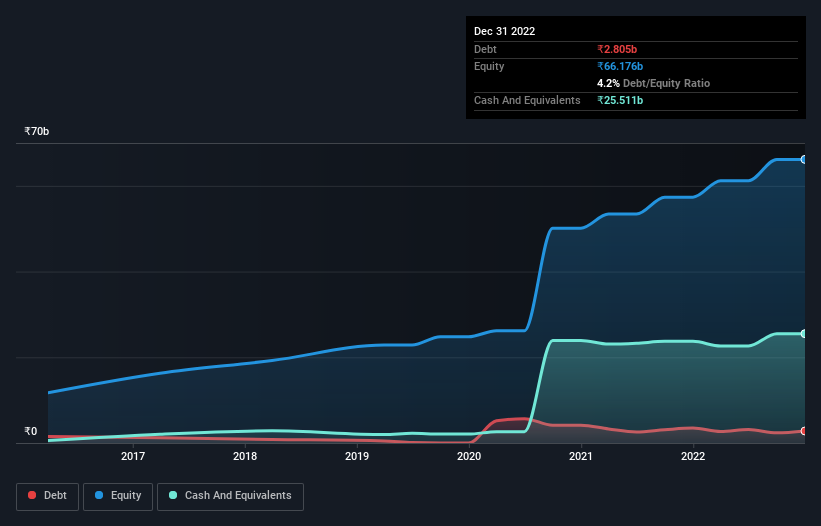We Think PI Industries (NSE:PIIND) Can Stay On Top Of Its Debt

Some say volatility, rather than debt, is the best way to think about risk as an investor, but Warren Buffett famously said that 'Volatility is far from synonymous with risk.' When we think about how risky a company is, we always like to look at its use of debt, since debt overload can lead to ruin. Importantly, PI Industries Limited (NSE:PIIND) does carry debt. But is this debt a concern to shareholders?
What Risk Does Debt Bring?
Debt and other liabilities become risky for a business when it cannot easily fulfill those obligations, either with free cash flow or by raising capital at an attractive price. If things get really bad, the lenders can take control of the business. However, a more common (but still painful) scenario is that it has to raise new equity capital at a low price, thus permanently diluting shareholders. Of course, debt can be an important tool in businesses, particularly capital heavy businesses. When we examine debt levels, we first consider both cash and debt levels, together.
View our latest analysis for PI Industries
What Is PI Industries's Net Debt?
The image below, which you can click on for greater detail, shows that PI Industries had debt of ₹2.81b at the end of September 2022, a reduction from ₹3.48b over a year. However, it does have ₹25.5b in cash offsetting this, leading to net cash of ₹22.7b.

How Strong Is PI Industries' Balance Sheet?
According to the last reported balance sheet, PI Industries had liabilities of ₹17.1b due within 12 months, and liabilities of ₹2.60b due beyond 12 months. Offsetting these obligations, it had cash of ₹25.5b as well as receivables valued at ₹15.3b due within 12 months. So it actually has ₹21.1b more liquid assets than total liabilities.
This short term liquidity is a sign that PI Industries could probably pay off its debt with ease, as its balance sheet is far from stretched. Simply put, the fact that PI Industries has more cash than debt is arguably a good indication that it can manage its debt safely.
On top of that, PI Industries grew its EBIT by 47% over the last twelve months, and that growth will make it easier to handle its debt. There's no doubt that we learn most about debt from the balance sheet. But it is future earnings, more than anything, that will determine PI Industries's ability to maintain a healthy balance sheet going forward. So if you want to see what the professionals think, you might find this free report on analyst profit forecasts to be interesting.
Finally, a business needs free cash flow to pay off debt; accounting profits just don't cut it. PI Industries may have net cash on the balance sheet, but it is still interesting to look at how well the business converts its earnings before interest and tax (EBIT) to free cash flow, because that will influence both its need for, and its capacity to manage debt. Looking at the most recent three years, PI Industries recorded free cash flow of 27% of its EBIT, which is weaker than we'd expect. That weak cash conversion makes it more difficult to handle indebtedness.
Summing Up
While it is always sensible to investigate a company's debt, in this case PI Industries has ₹22.7b in net cash and a decent-looking balance sheet. And it impressed us with its EBIT growth of 47% over the last year. So is PI Industries's debt a risk? It doesn't seem so to us. Above most other metrics, we think its important to track how fast earnings per share is growing, if at all. If you've also come to that realization, you're in luck, because today you can view this interactive graph of PI Industries's earnings per share history for free.
If, after all that, you're more interested in a fast growing company with a rock-solid balance sheet, then check out our list of net cash growth stocks without delay.
New: Manage All Your Stock Portfolios in One Place
We've created the ultimate portfolio companion for stock investors, and it's free.
• Connect an unlimited number of Portfolios and see your total in one currency
• Be alerted to new Warning Signs or Risks via email or mobile
• Track the Fair Value of your stocks
Have feedback on this article? Concerned about the content? Get in touch with us directly. Alternatively, email editorial-team (at) simplywallst.com.
This article by Simply Wall St is general in nature. We provide commentary based on historical data and analyst forecasts only using an unbiased methodology and our articles are not intended to be financial advice. It does not constitute a recommendation to buy or sell any stock, and does not take account of your objectives, or your financial situation. We aim to bring you long-term focused analysis driven by fundamental data. Note that our analysis may not factor in the latest price-sensitive company announcements or qualitative material. Simply Wall St has no position in any stocks mentioned.
About NSEI:PIIND
PI Industries
An agrisciences company, engages in the manufacture and distribution of agrochemicals in India, rest of Asia, North America, Europe, and internationally.
Excellent balance sheet with proven track record and pays a dividend.

